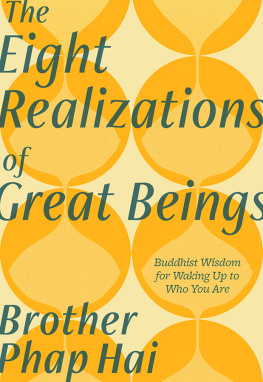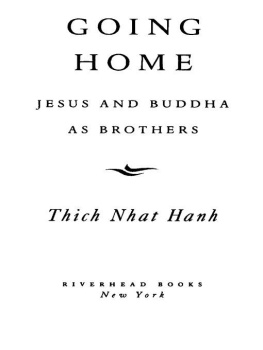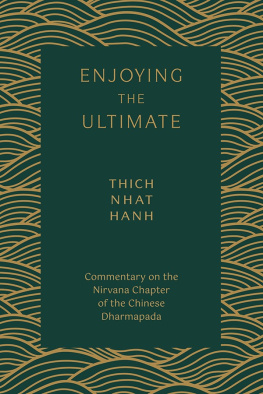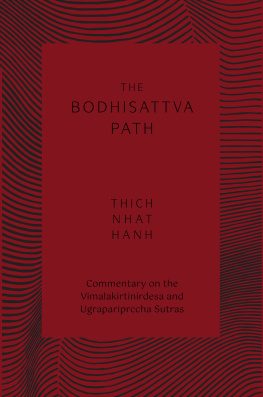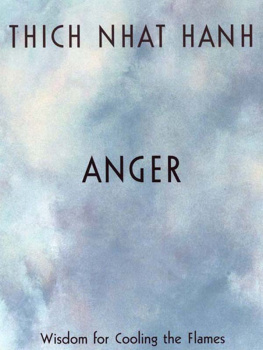
Praise for The Eight Realizations of Great Beings
Ive learned so much from Brother Phap Hai from his writings. His sincerity in the practice, compassion for all sentient beings, and skillful presentation of the Dharma have all been a source of inspiration. We are fortunate to have Brother Phap Hai as a guide.
from the foreword by Rebecca Li , PhD, Dharma teacher in the lineage of Chan Master Sheng Yen and author of Allow Joy into Our Hearts
Brother Phap Hai has done more than present a clear, dynamic path that leads toward awakening; he shares hard-earned spiritual insights and personal wisdom experienced over many years of meditation, reflection, and contemplation. His presentation of the Sutra on the Eight Realizations of Great Beings has wide application and relevance for students of all Buddhist traditions and all levels of practice. In this way Brother Phap Hai offers one of the greatest gifts anyone can offer: a mirror of dharma that allows the reader to not only see, but to begin to appreciate their fundamental buddha nature. This should be recognized to be a great gift to the world and is worthy of deep heart-felt praise.
Lama Justin von Bujdoss , cofounder of Bhumisparsha Sangha and author of Modern Tantric Buddhism: Embodiment and Authenticity in Dharma Practice
Brother Phap Hais authorship and stories make this sutras relevance alive for this moment in history. His heart at the center of the work shines with the brilliance of practice and study well lived and well shared. A must-read for practitioners and scholars alike.
Larry Ward , PhD, author of Americas Racial Karma
The Eight Realizations of Great Beings is the user manual for understanding how to navigate our lives in the continual churn of the pressure-packed, noisy, and often cruel modern world. Brother Phap Hai has made accessible the ancient wisdom of Buddhism, shedding a bright light on the truth of our existence. Explored gradually and patiently in small measures, this book helps our mind move towards the enlightenment that is inherent in all things.
Les Kaye , abbot of Kannon Do Zen Center and author of A Sense of Something Greater
Brother Phap Hai invites the reader along on his own journey through the Eight Realizations of Great Beingsfrom his initial resistance to the sutras seeming simplicity to his discovery of its profound beauty. It is an invitation to keep exploring for a lifetime, to ground ourselves in ordinary truths, to allow ourselves to wake up to something new.
Tracy Franz , author of My Year of Dirt and Water, in Lions Roar magazine
Brother Phap Hais down-to-earth approach and kindly humor make him the ideal guide to the profound teachings of the Sutra on the Eight Realizations of Great Beings, helping us find answers to the question, How do I apply the Dharma in my daily life?
Bodhipaksa , author of This Difficult Thing of Being Human
Thich Nhat Hanh loved the Eight Realizations of Great Beings. Brother Phap Hai has been living these teachings and his deep practice is evident in his reflections and insights. I appreciate Brother Phap Hais use of story and of humor; this to me is a sign of a great teacher.
Peggy Rowe Ward , author of Loves Garden
A student of Thich Nhat Hanh, Brother Phap Hai exudes an utterly contagious sense of calm, one that knows no boundaries of time or space. Through generous teaching and by sharing beautiful personal stories, he brings to life what first appears to be the driest of sutras. This book illuminates a road toward calm that each of us can travelso necessary now, on this storm-tossed boat of ours.
Joel ben Izzy , storyteller and author of The Beggar Kingandthe Secret of Happiness
Parallax Press
2236B Sixth Street
Berkeley, California 94710
parallax.org
Parallax Press is the publishing division of Plum Village Community of Engaged Buddhism
2021 Plum Village Community of Engaged Buddhism, Inc.
All rights reserved
No part of this book may be reproduced in any form or by any means, electronic or mechanical, without permission in writing from the publisher.
Cover and text design by Katie Eberle
Typesetting by Maureen Forys, Happenstance Type-O-Rama
Ven. Master Hsing Yuns translation of the Sutra on the Eight Realizations of Great Beings is excerpted courtesy of Buddhas Light Publications USA. The Chung Tai Translation Committees translation of the sutra is reprinted from Selected Texts for Buddhist Sutra Study, Nantou County, Taiwan (R.O.C.), 2019, courtesy of the Chung Tai Shan Buddhist Foundation, www.citworld.org.tw.
Library of Congress Cataloging-in-Publication Data
Names: Phap Hai, Brother, author.
Title: The eight realizations of great beings : Buddhist wisdom for waking up to who you are / Brother Phap Hai.
Description: First edition. | Berkeley : Parallax Press, 2021. | Includes bibliographical references.
Identifiers: LCCN 2021000926 (print) | LCCN 2021000927 (ebook) | ISBN 9781946764867 (trade paperback) | ISBN 9781946764874 (ebook)
Subjects: LCSH: Tripitaka. Sutrapitaka. Ba da ren jue JingCommentaries. | BuddhismDoctrines. | ConsciousnessReligious aspectsBuddhism. | Enlightenment (Buddhism) | Village des pruniers (Buddhist Community)
Classification: LCC BQ1529.5.P347 P43 2021 (print) | LCC BQ1529.5.P347
(ebook) | DDC 294.3/42dc23
LC record available at https://lccn.loc.gov/2021000926
LC ebook record available at https://lccn.loc.gov/2021000927
If we were not so single-minded
about keeping our lives moving,
and for once could do nothing,
perhaps a huge silence
might interrupt this sadness
of never understanding ourselves
and of threatening ourselves with death.
Perhaps the earth can teach us
as when everything seems dead
and later proves to be alive.
Pablo Neruda, Keeping Quiet
Illustrations
- The Silk Road and the transmission of Buddhism, with lines representing the major routes; among them, the most famous are the Oasis Route from Xian to Kashgar in China, the Steppe Route running through Central Asia, and the Maritime Route from Venice in Italy to Osaka in Japan, page 6.
- Location of Sogdia, 300 BCE; the Sogdians dominated trade along the Silk Road from 200 BCE through the tenth century, and thus played an active role in the spread of ideas, including Buddhism. Modern-day country borders are indicated with broken lines, page 7.
- A Caucasian Central Asian monk, possibly an Indo-European Sogdian, teaching an East Asian monk, who is perhaps a Turkic Uyghur or Han Chinese person, on a ninth-century CE fresco from the Bezeklik Thousand Buddhas Caves near Turfan, Xinjiang, China, page 9.
- The Five Skandhas, page 944.
- Brother Phap Hai as a five-year-old child, page 86.
- My father as a teenager, page 148.
- My mother, page 150.
- Gilt-bronze Maitreya in meditation, National Museum of Korea, page 237.
Foreword by Rebecca Li
It brings me great joy and happiness to be writing the foreword for this book. I remember reading, over twenty years ago now, Thich Nhat Hanhs beautiful foreword for a book by my teacher, the late Chan Master Sheng Yen, a commentary on the Sutra of Complete Enlightenment. I was deeply touched by Thays words of wisdom, respect, and friendship. Years later, I had the great fortune of meeting Thich Nhat Hanhs senior disciple, Brother Phap Hai, and we became good friends. We discovered that our Dharma names are derived from the same lineage verse of the Linji School used for naming disciples in our tradition, and our names share the same Chinese character. That makes us Dharma siblings. Ive learned so much from Brother Phap Hai from his writings and from working with him for the Gen X Buddhist Teachers Sangha. His sincerity in the practice, compassion for all sentient beings, and skillful presentation of the Dharma have all been a source of inspiration.
Next page
